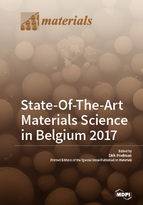State-of-the-Art Materials Science in Belgium 2017
A special issue of Materials (ISSN 1996-1944).
Deadline for manuscript submissions: closed (30 June 2018) | Viewed by 88653
Special Issue Editor
Interests: lighting, vision, and luminescence, displays; thin film optics; photocatalysis; medical imaging; structural characterization
Special Issues, Collections and Topics in MDPI journals
Special Issue Information
Dear colleagues,
Belgium is a small country. The days of minerals and ores from the former colony Congo have long passed by, and the last coal mine was closed 25 years ago. So, Belgium has hardly any physical resources which can be exploited in materials research and development, or industry. This drawback is compensated by focussing on highly technological fields of research, not requiring vast amounts of raw materials. This approach includes the development of new analytical methods for the characterization of materials, research into new advanced functional materials as well as finding new industrial processes utilizing existing materials.
This special issue aims at collecting an overview of materials research activities in Belgium. Research topics include, but are not limited to:
- Methods for the synthesis of new materials in powder, bulk or thin film form.
- Surface modification or functionalization of materials.
- Optical, electrical, mechanical or magnetic properties of materials.
- New methods for materials characterization.
- Material degradation and protection.
- Applications of advanced functional materials.
- Technologies for separation and recycling.
It is my pleasure to invite you to submit manuscripts on the subject “State-of-the-Art Materials Science in Belgium” for this Special Issue. Full papers, communications, as well as comprehensive reviews are welcome. Please feel free contact me as guest editor in case of further questions.
Prof. Dr. Dirk Poelman
Guest Editor
Manuscript Submission Information
Manuscripts should be submitted online at www.mdpi.com by registering and logging in to this website. Once you are registered, click here to go to the submission form. Manuscripts can be submitted until the deadline. All submissions that pass pre-check are peer-reviewed. Accepted papers will be published continuously in the journal (as soon as accepted) and will be listed together on the special issue website. Research articles, review articles as well as short communications are invited. For planned papers, a title and short abstract (about 100 words) can be sent to the Editorial Office for announcement on this website.
Submitted manuscripts should not have been published previously, nor be under consideration for publication elsewhere (except conference proceedings papers). All manuscripts are thoroughly refereed through a single-blind peer-review process. A guide for authors and other relevant information for submission of manuscripts is available on the Instructions for Authors page. Materials is an international peer-reviewed open access semimonthly journal published by MDPI.
Please visit the Instructions for Authors page before submitting a manuscript. The Article Processing Charge (APC) for publication in this open access journal is 2600 CHF (Swiss Francs). Submitted papers should be well formatted and use good English. Authors may use MDPI's English editing service prior to publication or during author revisions.
Keywords
- synthesis; characterization
- coatings; functional materials
- degradation; protection; recycling; circular economy







